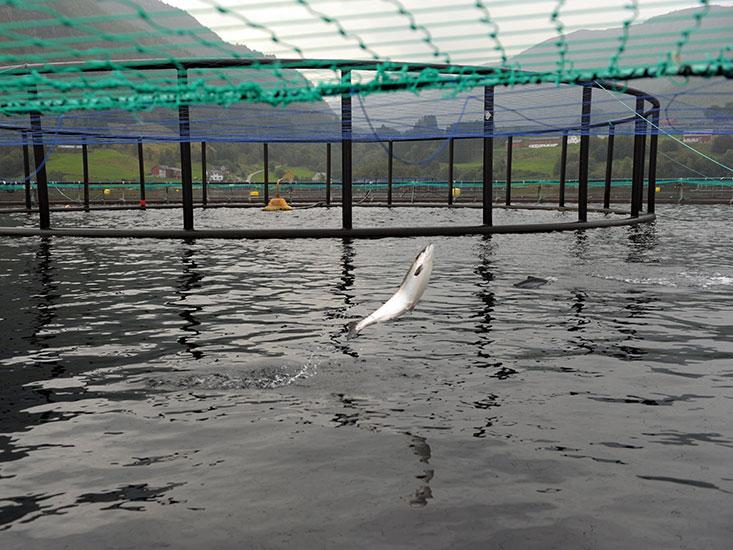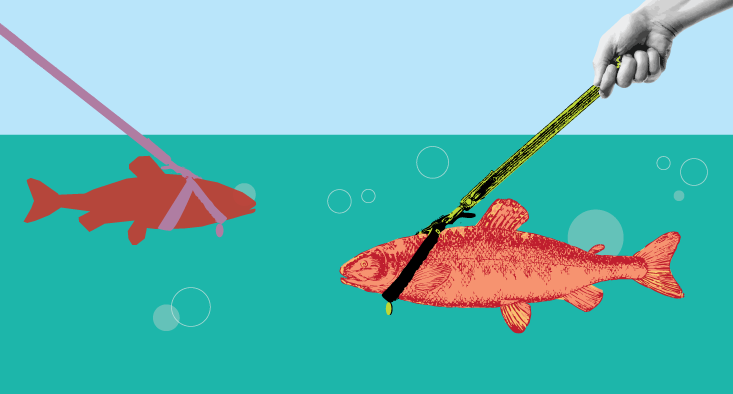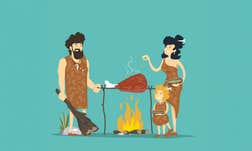The fish market has become the site of an ontological crisis. Detailed labels inform us where each fillet is from or how it was caught or whether it was farmed or wild-caught. Although we can now tell the farmed salmon from the wild, the degree of differences or similarities between the two defies straightforward labels. When a fish—or any animal—is removed from its wild habitat and domesticated over generations for human consumption, it changes—both the fish and our perception of it. The farmed and wild both say “salmon” on their labels, but are they both equally “salmon?” When does the label no longer apply?
This crisis of identity is ours to sort out; not the fish’s. For us, the salmon is an icon of the wild, braving thousand-mile treks through rivers and oceans, leaping up waterfalls to spawn or be caught in the clutches of a grizzly bear. The name “salmon” is likely derived from the Latin word, “salire,” to leap. But it’s a long way from a leaping wild salmon to schools of fish swimming in circles in dockside pens. Most of the salmon we eat today don’t leap and don’t migrate.
We now manage salmon’s evolution—even to the point of genetically modifying them to grow faster.
More than 90 percent of all the adult Atlantic salmon now on the planet are thought to be in salmon farms and almost all Atlantic salmon available in the United States at your local market is from a farm. This rise of the farmed salmon, and the decline of native ones, is casting the definition of species into doubt and in the process tweaking our relationship to nature. In a 1998 paper, Mart Gross, a conservation biologist, called for the recognition of a new creature, Salmo domesticus.
“Domesticated salmon are about as different from wild salmon as dogs are from wolves,” says Gross, a professor at the University of Toronto. Like dogs, these salmon now depend on humans for habitat and food, and we manage their evolution—even to the point of genetically modifying them to grow faster.
Salmon species aren’t the first to undergo this identity shift at our hands, but the transformation from a wild to domestic species has seldom happened as quickly. We are watching this one unfold within a single human lifetime. To Gross and other scientists, the rapid transformation epitomizes our Anthropocene epoch, where nature can no longer be separated from humans.

After Pacific and Atlantic salmon were separated, likely about 15 million years ago following the cooling of the Arctic Ocean, they continued to subdivide until, about 6 million years ago, today’s species emerged—one in the Atlantic and six in the Pacific. Over time, they further subdivided, in both ocean basins, into a multitude of genetically and morphologically distinct populations, custom-built for specific rivers and migration routes.
In the 1960s, a novel evolutionary event began to take place, and those distinctions began to fade. Norwegians began raising salmon in pens in fjords, industrializing the process so they controlled the entire means of production, roe to fillet. They weren’t the first to farm fish, but domesticizing a carnivorous fish that migrates thousands of miles through both fresh and saltwater was something new. The ecological impacts of raising such a fish in a concentrated pen aside, the farms provided a reliable, controlled supply of salmon for communities and, later, export.
That control also meant farmers could select for faster-growing, bigger, more docile fish, and over time the salmon inside the pens began to genetically diverge from the wild ones swimming by. Studies have described a “parallel evolution” in which wild and farmed salmon in Canada and Norway have become significantly different genetically over just five to seven generations of selective breeding. That artificial selection, through technological advances, is happening faster than the domestication of chickens, pigs, or cows.
Marianne E. Lien is an anthropologist at the University of Oslo. Earlier this year she published a book, Becoming Salmon: Aquaculture and the Domestication of a Fish, on the history and transformation of salmon aquaculture. As salmon are bred toward an increasingly homogenous, market-ready ideal, she says, their origins—adaptations to natal rivers and specific migration routes—are gradually being erased.
That matters because net pens can tear and mooring lines can break. A storm in central Norway in August 2005, for instance, broke lines and set free nearly a half million farmed salmon. In the North Atlantic, those escapees can interbreed with the remaining wild fish, pushing Atlantic salmon as a whole down a new evolutionary path on a much faster time scale than ever before.
Studies have found “hybrid” farmed-wild offspring have weaker genetic adaptations for the rivers and migratory paths of the wild. One study has found these interactions could potentially cause an “extinction vortex in vulnerable populations.” Hybrids are also reversing the genetic divergence in which salmon have evolved to thrive in unique rivers and conditions. Another study has forecast a decrease in “population differentiation” between previously distinct populations. “Now, salmon are distinguished in a new way—through the traits you select for in farming,” says Lien.
As salmon are bred toward an increasingly market-ready ideal, their origins are gradually being erased.
Over time, Atlantic salmon farming operations spread to new corners of the oceans. Farms in Chile and New Zealand brought Atlantic salmon to the other side of the world. Farms in British Columbia put Atlantic salmon right in the middle of Pacific salmon species’ habitat. There are now more Atlantic salmon on the planet than there have ever been before, a large proportion of them are nowhere near the Atlantic, and nearly all of them depend on humans for their habitat.
This is a direct reversal of the past hundred or so years of human-salmon interactions, in either ocean. In some ways, the domestication of salmon began long before large-scale farms came about, as they had to learn to adapt to living alongside our expanding communities, navigate dams and fish ladders and tolerating changing water conditions due to pollutants and lower water levels.
In the Pacific Ocean, this seeming incompatibility of human and salmon habitat has led to hatcheries that effectively “ranch” young salmon until they can be released to supplement depleted wild stocks. These have contributed to similar, though much less dramatic changes, as those in the Atlantic.
The Sacramento and San Joaquin rivers, for instance, used to teem with young smolt heading out to sea and mature salmon returning to spawn. Chinook salmon—still the most prized of the Pacific salmon—used to exist in several genetically and physiologically distinct populations, each returning at different times of the year through the Golden Gate to reach their native streams. As dams were built upstream and water pumped out for Central Valley farms and growing cities, those fish became increasingly less able to make it all the way out to sea and back again, and their populations faltered. Hatcheries were created to give those populations a boost and try to preserve the fishing industry and ecological effects of those salmon.
But, for Chinook, hatcheries raise largely the same, fall-run populations and the annual migrations of young fish out to sea now take place largely by truck, as smolt are shipped around low delta water levels to the sea. “Now there is little or no detectable genetic structure, no distinct populations, anymore. We’re producing one type of hatchery fish that is all released at nearly the same time,” says Robin Waples, a senior scientist with a background in population genetics at the National Oceanic and Atmospheric Administration.
As with farmed Atlantic salmon, which mainly come from a few Norwegian populations and have interbred with diverse wild species in Iceland, Canada, and Scotland, the distinctions that have emerged over millennia in the Pacific are being smoothed out, and new categories are emerging based not on rivers or runs or evolutionary history but on degree of complicity with human enterprise.

The new taxonomic picture of Atlantic salmon contains several categories. All the wild fish are contained within just one of those categories. The others are some combination of domestic fish, escaped “feral” fish, and escaped fish in exotic habitats. The categories matter because the categories determine how we perceive the changes we have created. Lien sees an inherently blurry line between what we deem acceptable in our rivers (wild salmon) and what we don’t (farmed escapees).
“Fishermen operate with the idea that escaped salmon don’t belong. But all these distinctions are arbitrary,” she says, comparing the line between each type of salmon to a color spectrum. “On a spectrum of brown to red, we cannot say exactly where the ‘red’ becomes ‘brown,’ but we can recognize that there is a difference between the two. How we cut the world into stable categories is always arbitrary.”
Even for biologists, the distinctions are blurry. Genetics is one way to demonstrate difference, but it is not the only one. No one, not even Darwin, has had a universal definition that could settle the debate over how to draw the speciation line.
“What we teach in school—because it’s easiest for students to understand—is the biological species concept,” says Gross: If two individuals cannot interbreed and reproduce successfully, they’re different species. But Gross notes that leaves out asexual organisms, including even some lizards and fish, and that there are more than 20 ways of differentiating species. “In reality, there is no such thing as a species. It’s an artificial construct that humans have applied to organize the biological world. We can’t just think all these species and names are chiseled in stone,” Gross says.
Not even Darwin could settle the debate over how to draw the speciation line.
There’s species, for instance, that would be able to interbreed successfully but which never encounter each other because they live in distant and different habitats. That is how Pacific and Atlantic salmon are thought to have initially diverged, separated by cold Arctic waters until they could no longer interbreed. Today, wild and farmed Atlantic salmon also live in separate habitats—wild waters and a carefully regulated farm. “Farmed Atlantic salmon have long been on the evolutionary path to being a new species,” Gross says. “You could even say they were already a different species when I wrote that paper [in 1998] because they already lived in a completely different habitat.”
Not all biologists agree. “Domestication causes genetic change under selection, but it doesn’t generate new species by any stretch,” says Michael Blouin, an evolutionary geneticist at Oregon State University. He says even domesticated pigs, chickens, and cows shouldn’t count as separate species, because they can still interbreed with their wild counterparts. And salmon, Blouin says, are “nowhere near that level of domestication.”
But salmon have changed, and that change has been more than genetic or morphological or geographic; it’s been a change in vocabulary and perception. Domestication has created a kind of relativity, undermining what makes a salmon a salmon. This generation’s grandkids will probably know salmon as that plentiful fish raised in pens, not as a creature that has evolved to migrate thousands of miles through freshwater, saltwater, over waterfalls, and around dams.
Gross sees domesticated salmon as “a continuation of human agricultural development that began 10,000 years ago.” Today, that agricultural enterprise is touching new species and leaving its mark on not just animals in pens but the ones that remain, to whatever degree, “wild.”
In the process, our relationship to animals, wild and tamed, is changing just as fast as we are changing them, and the wild is becoming increasingly less so. Eventually, Gross says, “there will be few wild species that are not altered by humans.”
Matthew Berger is a writer based in Portland. He has reported for Bloomberg, Agence France-Presse and Upworthy. @matthewoberger.


























